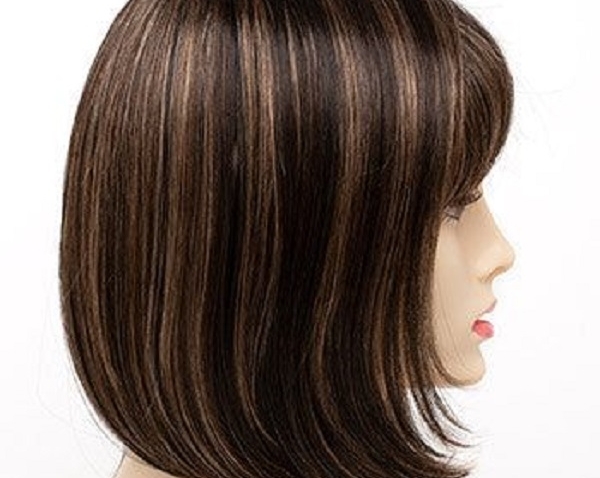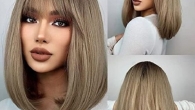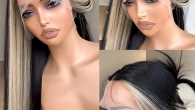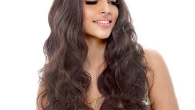
Styling Secrets for Ugly Wigs: Transform Your Look
The Basics of Wig Assessment
Before you can begin transforming an ugly wig, you must assess its current state. Start by examining the wig’s structure. Look for signs of wear such as fraying ends, faded color, and loss of volume. Also, check the wig’s scalp imitations and hairline for realism. It’s crucial to identify the type of fiber used since synthetic and human hair wigs require different care techniques.
Inspect the Wig’s Condition
Closely inspect for matting, tangles, and overall texture. Note areas that seem particularly damaged or dry. This will tell you how much work you need to put into the revival process. If the wig appears shiny and plastic-like, it may be a lower-quality synthetic piece which could be harder to rejuvenate.

Determine the Type of Fiber
Touch the fibers to determine if the wig is made from synthetic materials or natural human hair. This is important because certain styling tools and products are suitable for only one type of fiber. Synthetic fibers, for example, are more sensitive to heat and can easily melt or warp.
Evaluate the Cap Construction
Turn the wig inside out and look at the cap. Good-quality wigs usually have caps with adjustable straps and can be resized to better fit your head. If the cap is damaged or not adjustable, the wig may not sit comfortably or look natural when worn.
By properly assessing your ugly wig, you can make a more informed decision about the feasibility of its transformation. Keep these basics in mind, and you’ll be ready to embark on the journey of reviving your wig.
Essential Tools for Wig Revival
Gathering the right tools is crucial for reviving ugly wigs. First, arm yourself with a wide-tooth comb or a wig brush. These are gentle on wig fibers and help detangle without causing damage. Invest in a wig stand as well. It keeps the wig’s shape and makes styling easier.
Second, you’ll need suitable hair care products. Look for wig-friendly shampoos and conditioners free from sulfates. They cleanse while keeping the fibers intact. A leave-in conditioner is also essential. It adds moisture and shine to dull wigs.

Next, if you’re dealing with a synthetic wig, you must be cautious about heat. Use a steamer or a low-heat styling tool designed for synthetic fibers. These prevent the fibers from melting and warping.
Lastly, keep a small pair of hair scissors on hand. Trimming split ends or reshaping the wig can make a big difference. With these tools ready, you can tackle any ugly wig and bring it back to life.
Washing and Conditioning: Breathing New Life into Dull Wigs
Transforming ugly wigs starts with a proper wash and condition. Dirt, oil, and product build-up can make a wig look lifeless. Begin by choosing a shampoo made for wigs, preferably sulfate-free to protect the fibers. Use cool water to gently cleanse the wig. Avoid rubbing, as this can cause tangling.
After washing, apply a wig conditioner. Look for products that offer hydration without weighing down the wig. Apply the conditioner evenly, and let it sit for a few minutes. Rinse it out with cool water. This step helps to restore shine and smoothness.
For synthetic wigs, avoid using regular hair conditioners. These can harm the fibers. Instead, opt for sprays or leave-in conditioners designed for synthetic hair. They offer moisture without negative effects.
Once conditioned, pat the wig gently with a towel. Do not wring or twist the wig, as this can damage it. Leave the wig on a stand to air dry. Direct heat can harm wigs, especially synthetic ones. Let it dry naturally, and the transformation begins to take shape.
By washing and conditioning, you give ugly wigs a new chance at life. It’s a simple yet vital step in the revival process.
Cutting and Trimming: Shaping Your Wig for a Better Fit
Sometimes, ugly wigs just need a good trim to look fresh. Begin with clean, dry fibers. Comb the wig gently and decide on the style you aim for. Trim any frayed ends carefully, cutting small amounts at a time. If the wig’s length is excessive, shorten it to a more flattering look. Always use sharp scissors designed for hair cutting.
Snip with Care
Cutting hair requires precision. Start with small snips and avoid rushing the process. Remember, you can always trim more, but you can’t add back what you’ve cut off. Work your way around the wig, checking the shape from every angle.
Style and Shape
Even wigs with a basic cut become stylized with the right technique. For thicker-looking ends, cut directly across. For a feathered look, use a vertical snipping method. Choose a layered style to add volume and movement to flat, dull wigs.

Bangs and Fringe
Update your wig by adding bangs or fringe. This can hide a wig’s artificial hairline and create a modern look. Cut the bangs longer first, then adjust to the desired length.
Cutting and trimming are often the keys to transforming an ugly wig into a stylish accessory. With careful snips and the right cutting method, your wig can fit and flatter beautifully.
Styling Techniques for Upgrading Wig Appearance
Transforming ugly wigs goes beyond just cleaning and cutting. Styling is the next significant step to uplift its appearance. Here are several techniques to turn a drab wig to fab:
Choose the Right Styling Tools
Select tools that work best for wig fibers. For human hair wigs, regular styling tools will do. For synthetic wigs, opt for low-heat options. Curling irons and flat irons at a low temperature can safely create curls or straighten fibers.
Emphasize Texture and Volume
Create volume with teasing and hairspray. Use a wide-tooth comb to gently backcomb the wig. Apply wig-friendly hairspray to hold the shape. Be careful not to overdo it; aim for a natural look.
Experiment with Hairstyles
Try different hairstyles. Place the wig on a mannequin head and practice. Braiding, ponytails, or updos can hide imperfections and create a fresh look.
Use Styling Products Judiciously
Apply wig mousse or styling cream to shape and add texture. Avoid heavy products that can weigh down the wig or cause build-up. A light touch is key.

Heat-Free Alternatives
For synthetic wigs that can’t take heat, use foam rollers or flexi-rods. Leave them in overnight, and you’ll have curls by morning without risking damage.
By following these styling techniques, you can significantly upgrade the look of your ugly wigs. With a bit of practice, your wigs will look as good as new, and no one will be the wiser about their once ‘ugly’ state.
Dyeing Synthetic Wigs: Can You or Can’t You?
Changing the color of a wig can transform its appearance entirely. But when it comes to synthetic wigs, many wonder if dyeing is an option. The straightforward answer is yes, but with caution. Synthetic wigs require special dyes and methods as they do not respond to regular hair dye.
Understand the Fiber Limitations
Synthetic fibers aren’t like human hair. They don’t absorb color in the same way. Most synthetic wigs are made of plastic-based fibers. These fibers can melt or become damaged when you try to dye them with traditional hair dye. Look for dyes specifically made for synthetic wigs, which often come in a limited range of colors.
Test Before You Dye
Always test the dye on a small, hidden section of the wig first. This helps you see the outcome before committing. Apply a small amount of dye according to the product instructions. Wait for the recommended time, then rinse and dry the test strand. If the result is good, you can proceed with the entire wig.
Dyeing Process
Follow the dye’s instructions closely. Most procedures will have you shampooing the wig first. Mix the dye with the correct ratio of water or developer, if necessary. Use a dye brush and apply evenly, ensuring not to miss spots. After applying, let the dye sit for the specified time. Rinse the wig gently until the water runs clear. Let the wig air dry on a stand.
Limitations and Expectations
Don’t expect to lighten the color of a synthetic wig. Dyeing can usually only add a darker or similar shade to the original color. Also, understand that synthetic dye might fade over time and with washings.
Safety Precautions
Wear gloves to protect your hands and work in a well-ventilated area. Avoid using any heat on the wig while dyeing, as this can cause irreparable damage.
Through careful selection of dye and methodical application, you can dye ugly wigs made of synthetic fibers. However, weigh the risks and consider professional help if you’re unsure. Sometimes, a new wig might be a better investment than trying to change a tricky synthetic one.
Accessorizing: Enhancing Wigs with Headbands, Scarves, and More
Accessorizing is a creative way to add style to ugly wigs. With the right accessories, you can easily cover imperfections or enhance the wig’s appeal. Here are simple yet effective accessorizing tips:

Pick the Perfect Headband
Headbands add style and hide flawed hairlines. Choose one that complements your wig’s color and texture. A wide headband can cover more area, providing both style and coverage.
Utilize Scarves for a Chic Look
Scarves offer versatility in styling. Wrap a scarf around the wig for a bohemian vibe or tie it into a bow for a sweet touch. Go with light fabrics for a gentle look.
Clip-on Flowers or Hairpins for Elegance
Add a touch of elegance with flowers or decorative hairpins. Position them strategically to hide thin spots or to add a focal point to your style.
Experiment with Hats
Hats aren’t just for bad hair days. A stylish cap or beret can completely change your look and works well to mask wigs that are less than perfect.
Choose the Right Accessories
Always select accessories that don’t strain or pull on the wig. A light touch is best to avoid any damage. Look for items that complement rather than overwhelm the wig.
With these simple accents, even the most unappealing wigs can look fashionable. Experiment and have fun dressing up your wig, and you’ll find that accessorizing can make a world of difference.
When to Call It Quits: Recognizing When a Wig Can’t Be Saved
Sometimes, despite all efforts, a wig goes beyond revival. Recognize when it’s time to stop. Look for these signs:

- Heavy Matting and Tangling: If combing doesn’t solve the issue, it may be irreversible.
- Extreme Fiber Damage: Burnt or melted areas on synthetic wigs signal the end.
- Persistent Bad Smell: Odors that linger after washing can indicate deep-set issues.
- Disintegrating Cap: A cap falling apart impacts fit and can’t support fibers.
- Extensive Color Fade: Some wigs lose color to a point where they look unnatural.
- Loss of Hair Strands: When a wig sheds excessively, it gets too thin to style.
- Overall Dullness: Some wigs can’t regain their shine, looking perpetually lifeless.
If your ugly wig shows these signs, it’s time for a new start. Move on and invest in a new piece. Replacing a wig that can’t be saved will save time and frustration in the long run. Sometimes, letting go is part of the transformation journey.












Leave a Reply